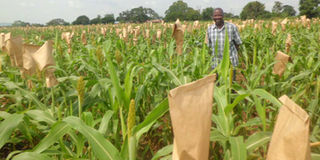Sorghum for beer provided many farmers with another way to make more money

Scientists inspecting sorghum planted at one of the fields at the research institute in Serere. PHOTO BY LOMINDA AFEDRARU.
What you need to know:
Close to his retirement age, the soft spoken Johnnie Ebiyau still lights the torch of breeding epuripur making him a leading scientist behind one of the world’s best sorghum varieties for brewing beer.
Close to his retirement age, the soft spoken Johnnie Ebiyau still lights the torch of breeding epuripur making him a leading scientist behind one of the world’s best sorghum varieties for brewing beer.
Cereal crops are bred in National NaSSARI, in Serere District with sorghum taking the biggest percentage given its industrial use and as food and feed by humans and livestock.
Ebiyau is a senior research officer at National Semi-Arid Resources Research Institute (NaSSARI). “At first, I never thought of studying agriculture,” says Ebiyau, who holds a Master’s degree in agriculture majoring on cereal crop breeding.
He studied botany and zoology for his first degree at Makerere University in 1979 but picked interest in agriculture after realising that there were few scientists in the field. He chose to specialise in sorghum breeding to bolster sorghum farming in the country.
Ebiyau says that sorghum, especially epuripur, earns farmers Shs8b annually from sales to breweries.
His home area, Ngora, which was part of Kumi District, but now a district, is reknown for growing sorghum. “I fell in love with sorghum since it is the third most important staple cereal crop in Uganda occupying 265,000 hectares of arable land,” he says.
Support structure
The crop is grown mainly in highlands in south western and in the lowland areas of east and northern Uganda. According to the UN Food and Agriculture Organisation (FAO), the area planted with sorghum remains stable, though the production has decreased from 467,000 tonnes in 1975 to 430,000 tonnes in 2002.
A detailed survey of the sorghum sector was undertaken in 2001 to determine the size of the industry, the areas where sorghum is grown most and what support infrastructure existed.
The findings were that while sorghum is widely grown, the annual tonnage had been declining. This was as a result of lack of available markets as sorghum was used only for food and brew at household level. The dominant varieties were red sorghums, which were unsuitable for beer brewing purposes.
However, Ebiyau says, there were several improved varieties, especially brown and white sorghums in the public domain. These had the potential to be utilised in the brewery industry; they include Sekedo 1995 and Epuripur 1995, SESO 1, SESO2 and SESO3 2012.
In his work as a researcher, despite being assisted by other scientists, Ebiyau has produced and commercialised five different sorghum strains. These hybrids provide different tastes, give resistance to crops against pests and have high yields. Samples of six sorghum varieties were collected in 2001 and taken to South Africa for grain quality analysis and trials on a pilot brewing study in Johannesburg.
Epuripur was found to posses excellent brewing qualities. The variety had been released in 1995 by Serere Agricultural and Animal Production Research Institute, as it was known then. Its development was through pure line selection.
Intergrated approach
Ebiyau explains, “In Uganda, the Striga infested area is estimated at 107,798 hectares, by mainly Striga hermonthica and Striga asiatica, causing yield losses of about 60 to 100 per cent under severe infestation.”
One Striga plant produces over 50,000 seeds and can remain dormant and viable in the soil for up to 20 years.
If a farmer manages to eliminate Striga from his farm, he would significantly increase the production of sorghum.
There is no single method devised that can effectively control Striga but an integrated approach is an acceptable solution especially for smallholder farmers.
The only option that a farmer has is to plant resistant varieties, intercropping sorghum/legumes, crop rotation, soil fertility improvement methods can be used to control Striga in sorghum.
Ebiyau was made a Principal Investigator on a DfID-funded integrated Striga management project by National Agricultural Research Organisation.
Sorghum is grown as a single crop especially by the large-scale farmers. But it can be intercropped with legumes such as cowpeas, green gram, and lablab bean by small-scale farmers for protein to supplement carbohydrates and starch from sorghum.
Recognition
Association for Strengthening Agricultural Research in Eastern and Central Africa (Asareca) has been implementing a sorghum-legume project at NaSARRI since 2011. The project address the challenges of climate change and dwindling soil fertility. In addition to Uganda, the project is operational in Eritrea, Sudan, Tanzania, Kenya and Uganda.
It involves several stakeholders that include NARO, ICRISAT, NAADS, local governments, NGOs, seed companies, grain processors, and farmer groups.
Without specifying the prices of sorghum, Ebiyau says certified breeds, however, go for a higher price than regular seeds. “For us to be able to maintain these seeds, we do not discard the traditional seeds. We have to keep growing them so that we can maintain the original seeds,” he added.
On what has enabled Ebiyau to achieve in his field, he cites determination, passion and hard work as the key attributes, as well as encouragement from parents, family and workmates. He recognises Dr Joseph Oryokot, former director at Serere and later the deputy director, National Agricultural Advisory Services (Naads) and Dr Peter Esele for mentoring him.




